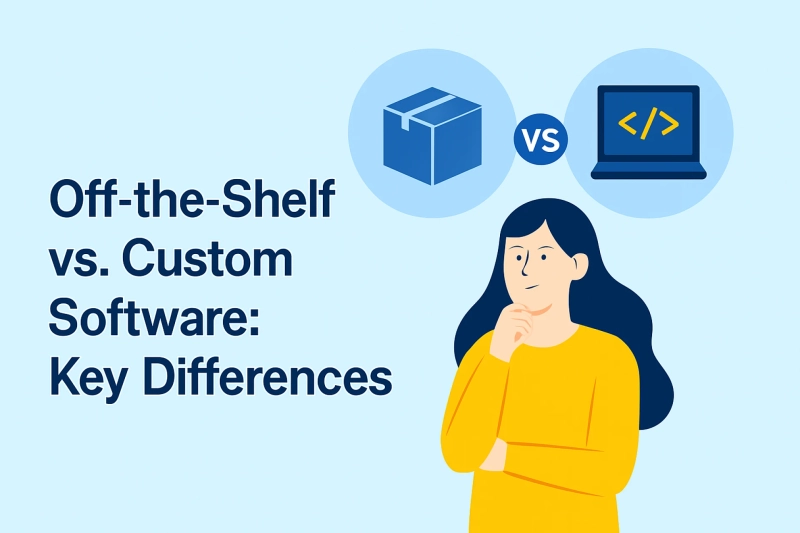Software is now an integral component of how companies operate, compete and expand. Whether it is a small startup or a large corporation, proper equipment can create a big difference in terms of efficiency, customer service and development. Perhaps one of the most important initial decisions for a business is whether to use off-the-shelf or custom software.
In this tutorial, I'm going to dive into the basic differences between off-the-shelf vs custom software, its pros and cons, and examples utilized in real life to help you decide what to use in your business.
What Is Off-the-Shelf Software?
Off-the-Shelf software is already existing software that is produced and made available to a large audience. Such products are designed to fulfill average business needs and are usually ready for use once purchased.
Examples of Off-the-Shelf Software:
- Microsoft Office
- Zoom
- Salesforce (base package)
- Trello
These types of products are usually subscription-based and backed by major corporations that provide updates and end-user support.
What Is Custom Software?
Custom software is written from scratch to meet a particular company's requirements. It's usually designed with the involvement of a software firm or in-house development team to make the product that comes out look very much like company processes, objectives, and user expectations.
Examples of Custom Software:
- A custom CRM for a legal practice
- A supply chain software tailored to one specific industry
- A custom mobile ordering and reservation system for a restaurant
Custom solutions provide you with full design, feature, and scalability control.
Off-the-Shelf vs Custom Software: Primary Differences
We will break down the difference between off-the-shelf and custom software by using the most important factors businesses generally consider.
1. Cost
- Off-the-Shelf: They are less expensive to buy outright. You pay a one-time license or subscription fee and use it as-is. What you may spend more on over time are extra features, integrations, or upgrades.
- Custom Software: It costs more upfront, since you're building it from the ground up. But you control it completely and end up saving money in the long term with automation, better integration, and scalability.
2. Deployment Speed
- Off-the-Shelf: You deploy and start using the software immediately. There is no development time.
- Custom Software: Time to plan, create, test, and deploy. This can range from several weeks to several months depending on how complicated it is.
3. Scalability and Flexibility
- Off-the-Shelf: They're built to be mass market, so they're typically not too accommodating to your individual workflows.
- Custom Software: It's written according to your particular needs and can evolve with your business. You can add features, remove the extraneous, and scale it as needed.
4. Integration
- Off-the-Shelf: Integrate these products with your current systems, and you may have some issues. Compatibility limitations can become barriers.
- Custom Software: It's made to integrate with your existing tools and tech stack. This seamless integration results in less disruption and streamlined operations.
For example, many growing businesses work with a Los Angeles software development company to create platforms that connect seamlessly with third-party tools and internal systems.
5. Ownership and Control
- Off-the-Shelf: You’re dependent on the vendor. If they remove a feature or change the pricing model, you’re stuck with it.
- Custom Software: You own the software absolutely, so you can change, update, or expand upon it as you wish. No dependence on external suppliers.
Advantages and Disadvantages of Off-the-Shelf Software
Below are the benefits and drawbacks of off-the-shelf software to assist you in making a decision as to what is best for you:
Advantages:
- Easy installation and deployment
- Less upfront cost
- Easy to locate support and community forums
- Proven and tried by multiple users
Disadvantages:
- Fixed flexibility
- Hidden upgrade and integration costs
- May include unwanted functionality
- Vendor risk of discontinuation
Pros and Cons of Custom Software
The following are the pros and cons of custom software to assist you in making the right decision:
Pros:
- Tailor-made to address your business needs
- Total control and ownership
- Easily scalable for future growth
- Improved integration with existing systems
Cons:
- Higher up-front investment
- Longer development cycle
- Requires technical personnel to support
- May require training upfront for personnel
When to Select Off-the-Shelf vs Custom Software
If you are not quite sure whether off-the-shelf or custom software is an ideal choice for your business, then it actually depends on your specific goals, budget, and timelines.
Below are normal landscapes that will inspire you to choose from each other:
Choose Off-the-Shelf Software If:
- You need an immediate and low-cost solution
- Your requirements are straightforward and uncomplicated
- You're prepared to make adjustments to your work flows
Choose Custom Software If:
- You have particular needs that standard tools do not cover
- You desire lasting scalability and flexibility
- You prefer complete ownership and control
Final Considerations
Deciding between off-the-shelf vs custom software is based on your intentions, deadline, and the specificity of your software requirements. Off-the-shelf options are cheaper and quicker to deploy but may stifle your expansion. Custom software takes more planning and dollars but provides long-term value and autonomy.
If your business needs tailored solutions, tailored software can give you the efficiency competitive edge, innovation edge, and user experience edge. Take the time to understand where you are and where you want to be. The right software choice will get you there faster and wiser.



